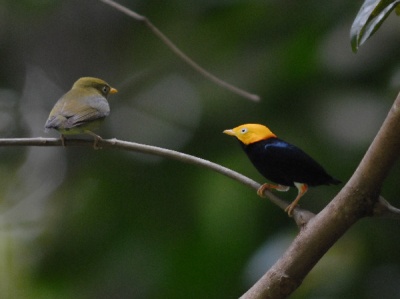- Ceratopipra erythrocephala
Dixiphia erythrocephala
Identification
Male: yellow head, black body, white iris and pale bill.
Distribution
Central and South America
Central America: occurs only in Panama
South America: found in Colombia, Venezuela, Trinidad and Tobago, Guianas, Suriname, French Guiana, Ecuador, Peru and Brazil (only north of the Amazon).

Photographed: Asa Wright Nature Centre, Arima valley, Trinidad, January 2007
Taxonomy
Formerly placed in genus Pipra.
Subspecies
There are 3 subspecies[1]:
- C. e. erythrocephala:
- C. e. berlepschi:
- C. e. flammiceps:
- Eastern Colombia (Santander)
Habitat
Forest and woodland including second growth on firm ground but mostly humid lowland (to 500 m in most of range, double that sometimes).
Behaviour
Breeding
Males spend most of their lives at the lek whilst females are life-long single mothers. Leks are typically high up in the canopy & difficult to observe. Display groups contain 6-20 males who call, jump and 'moonwalk' along thin horizontal branches.
Diet
These birds feed on the fruits of Melastomaceae which are so easy to collect that only an hour or so each day is spent foraging. Also berries and insects are included in the diet. Most fouraging occur at mid to low height in the forest.
References
- Clements, J. F., T. S. Schulenberg, M. J. Iliff, D. Roberson, T. A. Fredericks, B. L. Sullivan, and C. L. Wood. 2015. The eBird/Clements checklist of birds of the world: v2015, with updates to August 2015. Downloaded from http://www.birds.cornell.edu/clementschecklist/download/
- Gill, F and D Donsker (Eds). 2016. IOC World Bird Names (version 6.3). Available at http://www.worldbirdnames.org/.
- Avibase
- Restall et al. 2006. Birds of Northern South America. Yale University Press. ISBN 9780300124156
Recommended Citation
- BirdForum Opus contributors. (2024) Golden-headed Manakin. In: BirdForum, the forum for wild birds and birding. Retrieved 24 April 2024 from https://www.birdforum.net/opus/Golden-headed_Manakin




